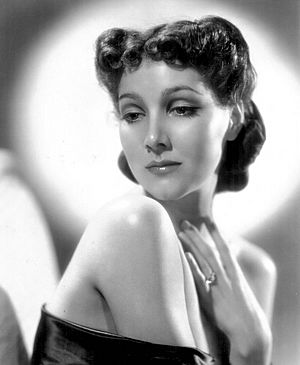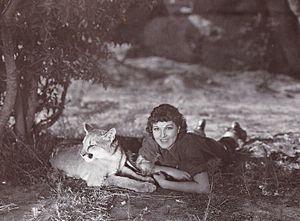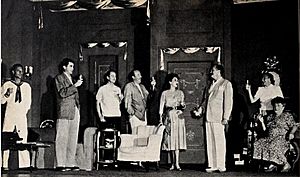Jean Parker facts for kids
Quick facts for kids
Jean Parker
|
|
|---|---|

Parker in 1933
|
|
| Born |
Lois May Green
August 11, 1915 Deer Lodge, Montana, U.S.
|
| Died | November 30, 2005 (aged 90) Los Angeles, California, U.S.
|
| Resting place | Forest Lawn Memorial Park (Hollywood Hills) |
| Years active | 1932–1966 |
| Spouse(s) |
George MacDonald
(m. 1936; div. 1940)Douglas Dawson
(m. 1941; div. 1943)Curtis Grotter
(m. 1944; div. 1948)Robert Lowery
(m. 1951; died 1971) |
| Children | 1 |
Jean Parker (born Lois May Green; August 11, 1915 – November 30, 2005) was an American film and stage actress. She was born in Montana and grew up during the Great Depression, a time when many people faced financial hardship. At age ten, she was adopted by a family in Pasadena, California.
Jean Parker first wanted to be an artist. However, at 17, her photo was published in a Los Angeles newspaper after she won a poster contest. This led to her being discovered by Louis B. Mayer, a top executive at Metro-Goldwyn-Mayer (MGM) film studio.
She made her first movie, Divorce in the Family, in 1932. She then starred in Lady for a Day (1933) and played Elizabeth March in the famous film Little Women (1933) alongside Katharine Hepburn. Later, she appeared in comedies like The Flying Deuces (1939) with Laurel and Hardy. She also acted on Broadway in plays such as Loco and Burlesque.
By the 1950s, her film career slowed down. She had one child, a son named Robert, in 1952. Jean Parker's last movie was Apache Uprising in 1965. She passed away in Los Angeles in 2005.
Contents
Biography
Early Life in Montana (1915–1932)
Jean Parker was born Lois May Green on August 11, 1915, in Deer Lodge, Montana. Her father, Lewis A. Green, was a gunsmith, and her mother was Perl Melvina Burch. Her family faced financial difficulties when she was young.
Between the ages of six and ten, she was adopted by the Spickard family. She then moved to Pasadena, California, where she went to elementary school and later graduated from John Muir High School.
Jean Parker's dream was to become an artist and illustrator. In 1932, when she was 17, she entered a poster drawing competition. Her photo appeared in a Los Angeles newspaper because of this contest. An assistant to MGM executive Louis B. Mayer saw her picture and arranged for her to have a screen test. Jean Parker later said, "My ambition was to be an artist. I had no thought of acting."
Starting Her Acting Career (1932–1937)
After a successful screen test, Jean Parker signed with MGM and was given her stage name. Her first movie was the drama Divorce in the Family (1932). She also had a small role in Rasputin and the Empress (1932).
In 1933, MGM lent Parker to Columbia Pictures. This gave her bigger roles, starting with Lady for a Day. In this film, she played the daughter of a poor saleswoman in New York City. The same year, she played Elizabeth March in Little Women. She acted alongside famous stars like Katharine Hepburn.
Jean Parker later said that playing Beth in Little Women was very challenging. She felt scared because she had little acting training. She was only 16, while her co-stars were much older. However, the other actresses, especially Miss Hepburn, helped her a lot.

In 1934, she got her first starring role in Two Alone. She then starred in several MGM films. These included Sequoia, where she played a woman living in the forests with a mountain lion. She also starred in Operator 13 and A Wicked Woman. She also appeared in the British film The Ghost Goes West.
Even while acting, Jean Parker continued to use her artistic skills. In 1935, she signed a contract to create eight sketches each month for a shop in Beverly Hills. In 1936, she married George E. McDonald in Las Vegas.
Film and Stage Roles (1938–1949)
In 1938, Jean Parker had the main role in Romance of the Limberlost. In 1939, she had a supporting role in the comedy The Flying Deuces with Stan Laurel and Oliver Hardy.
Her marriage to George McDonald ended in 1941. She then married Douglas Dawson in February 1941. They even ran a flying service together for a short time. This service closed when World War II began. They divorced in 1943. In 1944, Jean Parker married Dr. Kurt "Curtis" Arthur Grotter.

Jean Parker continued to act in films during the war. She starred with Lon Chaney Jr. in the thriller Dead Man's Eyes (1944). She also played the main character in two mystery films, Detective Kitty O'Day (1944) and Adventures of Kitty O'Day (1945).
In the late 1940s, she began acting on stage. She made her Broadway debut in the play Loco in 1946. She also had a starring role in Burlesque (1946–1947). In 1948, she took over the lead role in the touring Broadway production of Born Yesterday. Her performance was highly praised by audiences and critics.
In 1949, Jean Parker appeared in the comedy play Light Up the Sky with Gregory Peck. Her third marriage to Curtis Grotter ended in 1949.
Later Career and Retirement (1950–2005)
Jean Parker continued to tour with Born Yesterday into 1950. That same year, she returned to films with a supporting role in The Gunfighter, again with Gregory Peck.
In 1951, while visiting Sydney, Australia, she made headlines. A swimsuit inspector asked her to leave Bondi Beach because her bikini was considered too small.
On May 19, 1951, Jean Parker secretly married actor Robert Lowery Hanks. They had acted together in the 1944 film The Navy Way. In 1952, Jean Parker gave birth to their only child, a son named Robert Lowery Hanks II.
She continued to appear in films occasionally in the 1950s. These included a starring role in Black Tuesday (1954) and a role in A Lawless Street (1955). In 1954, she played "Cattle Kate Watson" in an episode of the TV series Stories of the Century.
Later in her career, Jean Parker also worked as an acting coach. Her last film appearance was in Apache Uprising (1965). She spent her later years mostly away from the public eye. In 1998, she moved into the Motion Picture and Television Country House and Hospital in Los Angeles.
Death
Jean Parker died from a stroke at the Motion Picture and Television Country House and Hospital on November 30, 2005. She is buried at the Forest Lawn Memorial Park in Hollywood Hills.
Legacy
Columnist Erskine Johnson once called Jean Parker "the Liz Taylor of the 1930s." After her death, journalist Ronald Bergan said that Parker was an underrated actress. He felt her career could have been even more successful if the studio system had given her more chances to show her talent.
Filmography
See also
 In Spanish: Jean Parker para niños
In Spanish: Jean Parker para niños


